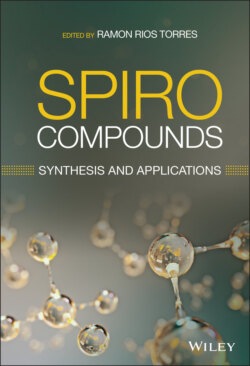Читать книгу Spiro Compounds - Группа авторов - Страница 21
3.1 Introduction
ОглавлениеSpiro compounds are organic molecules that present a twisted structure where two perpendicular cycles are linked together by a single tetrasubstituted stereogenic center, known as the spiro center. Since its definition in early 1900 [1], spiro compounds have attracted the attention of the scientific community owing to their unique features. The spiranic motif is present in several natural and non‐natural compounds possessing a wide range of biological activities [2]. As a result, the introduction of spiranic scaffolds in drug candidates is gaining interest in modern drug discovery programs [3]. Their well‐defined 3D structure along with the enhanced conformational rigidity offer distinctive features for new drug candidates, such as enhanced drug–target recognition or improved physicochemical properties [3]. Hence, the increasing demand of new compounds derived from privileged scaffolds in chemistry, biology, and medicinal research has fueled the development of novel methodologies toward the synthesis of spiro compounds [4]. In addition, the construction of spiro centers in a catalytic, stereocontrolled manner represents by itself a formidable synthetic challenge. In this light, methodologies based on the catalysis by organometallic complexes offer a robust approach for the discovery of novel cycloaddition reactions [5]. The versatility of the diverse transition metals, such as Cu, Rh, or Ni, together with the development of new chiral ligands make the use of transition‐metal catalysts a very powerful approach. Recently, the advent of organocatalysis has paved the way for unprecedented activation modes and reaction pathways [6], including cyclization, cycloaddition, and cascade transformations [7], representing a complementary and straightforward approach to construct spiro compounds in asymmetric fashion.
The present chapter assesses the most relevant synthetic methodologies toward the asymmetric catalytic construction of spirocyclic compounds by means of either cycloaddition or formal cycloaddition processes published between 2015 and 2019. Therefore, the most significant transformations have been selected regardless of the concerted or stepwise nature of the reaction mechanism. For each transformation, the substrate scope, the generality, and limitations as well as the key reaction mechanism are discussed. The chapter is divided between organometallic and organocatalytic strategies, and within each section, the different methodologies are classified according to the number of atoms involved in the formation of the spiro cycle.
